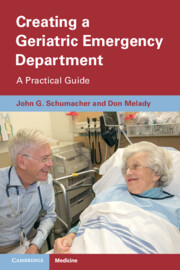Book contents
- Creating a Geriatric Emergency Department
- Creating a Geriatric Emergency Department
- Copyright page
- Dedication
- Contents
- Acknowledgments
- Introduction
- Chapter 1 Making the Case for a Geriatric Emergency Department
- Chapter 2 Starting a Geriatric Emergency Department
- Chapter 3 Overcoming Resistance: What to Do with “Yeah, But…”
- Chapter 4 You: An Approach to Your Older Emergency Department Patients
- Chapter 5 People: Adding Staffing and Training
- Chapter 6 Processes: Implementing Protocols and Policies
- Chapter 7 Place: Addressing the Physical Environment
- Chapter 8 Quality Improvement in the Geriatric Emergency Department: Getting Started
- Chapter 9 Launching Your Geriatric Emergency Department: From First Steps to Accreditation
- Appendix: Practical Resources and Links
- Index
- References
Chapter 4 - You: An Approach to Your Older Emergency Department Patients
Published online by Cambridge University Press: 20 January 2022
- Creating a Geriatric Emergency Department
- Creating a Geriatric Emergency Department
- Copyright page
- Dedication
- Contents
- Acknowledgments
- Introduction
- Chapter 1 Making the Case for a Geriatric Emergency Department
- Chapter 2 Starting a Geriatric Emergency Department
- Chapter 3 Overcoming Resistance: What to Do with “Yeah, But…”
- Chapter 4 You: An Approach to Your Older Emergency Department Patients
- Chapter 5 People: Adding Staffing and Training
- Chapter 6 Processes: Implementing Protocols and Policies
- Chapter 7 Place: Addressing the Physical Environment
- Chapter 8 Quality Improvement in the Geriatric Emergency Department: Getting Started
- Chapter 9 Launching Your Geriatric Emergency Department: From First Steps to Accreditation
- Appendix: Practical Resources and Links
- Index
- References
Summary
Presents practical tips to help clinicians go from good to great in their approach to older patients. Reviews key skills, knowledge, and attitudes about older people that they probably didn’t learn in their training to add to their approach for better outcomes. Treat the person not the person’s age. Sit down. Talk slowly not loudly. Think broadly not algorithmically. Drugs, drugs, drugs. Go for a walk. Be a team player. Learn about frailty.
- Type
- Chapter
- Information
- Creating a Geriatric Emergency DepartmentA Practical Guide, pp. 40 - 47Publisher: Cambridge University PressPrint publication year: 2022

